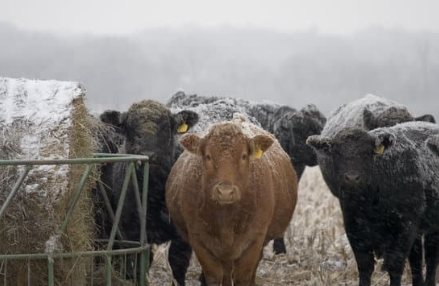
With the cold front coming in and possibly bringing in some winter precipitation with it, now is the time to prepare for any extra precautions you may need to take with your livestock. This extremely cold weather could last for several days, so it is important to be as prepared for that as possible! Pam Knox, Director of the UGA Weather Network, points out in her newest blog post ‘The coming cold weather-what we can say so far’, that the cold front is expected to stick around longer than we are accustomed to, so that means it is more likely for “livestock to experience frostbite and reduction of body temperature (especially calves and older animals on their extremities like ears and tails)”. The following sections will include some tips from Lawton Stewart, UGA Beef Cattle Specialist.
One thing to think about providing, that often gets overlooked, is a windbreak. Cattle will often seek a break from the wind and will even prioritize it over food and water in certain conditions. Stands of trees, stacks of round bales, or man-made structures are all common examples. Since they will look for this instead of worrying about food, place a windbreak close to their food source so that the animals can find relief from the wind and still get their correct number of calories to maintain themselves, and make sure they are eating enough to produce their own body heat. A windbreak is a huge factor to help cattle get through extreme cold.
Another important piece of the puzzle is nutrition. Cattle need more calories to maintain their body heat in extreme cold; up to 30% more. Starting at least 1-2 days prior to the expected weather, plan on offering higher quality hay or feeding 4-6 pounds of supplement. If cattle are not already receiving corn, do not start feeding straight corn. Lawton says he would recommend that the supplement be greater than 70% TDN and 15% CP. A few simple options: Whole cottonseed, Dried distillers’ grains, Corn gluten feed, 50:50 of corn gluten feed and soybean hulls, 33:33:33 of corn gluten feed, corn, and soybean hulls, Commercial feed.
We will see water troughs freezing once the temperature begins to drop. Make sure that you are checking your water source to make sure it is accessible. You may have to break and remove ice several times a day. In some instances, a heating system can be used, as well as a pond aerator to help combat freezing. (The aerators can be used in troughs as well as ponds). However, in the field these are not always viable options without power. Some solar powered options are available, but they tend to be more expensive.
There are also a few things to keep in mind for show animals that will apply to all species. If possible, bring these animals inside an enclosed barn or pen for the night. You want to keep them as warm and dry as possible, which is easier to do if they are inside. You can bed them down on oat/wheat straw – you want them off the cold ground or concrete floors. Make sure these animals have water, and break/remove ice as necessary. You also may want to increase the amount of food that you are giving them. They will be converting this feed into heat and not body weight when it is super cold outside, so that is something that you should keep in mind. Their body’s main priority is staying warm. Please reach out to me at mckenzie.wheeler@uga.edu or at 706-629-8685 if you have any questions! We have two programs coming up this month, one on beekeeping on January 13th, and the other is a chance to get pesticide CEUs on January 15th. Please reach out to me for more information on these as well. Happy New Year!